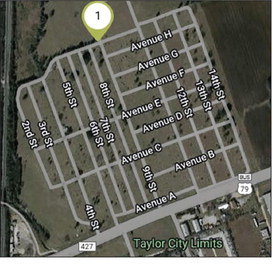Taylor's lost graves find respect African American resting places receive a historical monument
Time may have erased a significant part of Taylor’s history, but local leaders Thursday plan to rectify that situation by announcing the dedication of a monument in the historical African American section of the city cemetery.
At the City Council meeting 6 p.m. Thursday, Jan. 23, the city will honor some of its founding families by making a “presentation on the Historical African American Burial Section Monument Unveiling and Dedication at the Taylor Cemetery,” according to an agenda.
In the graveyard, many of the town’s first families are buried where wooden markers have decayed away.
“There are many in the city of Taylor cemetery whose names and burial locations have been lost,” said Mayor Dwayne Ariola. “In fact, my grandmother was buried in Taylor City Cemetery in 1941. Her marker was lost in a flood, and no one alive remembers where it was.”
He added, “It warms my heart to know that the families of those buried in the Historical African American section of the cemetery will now have a permanent marker to remember them by.”
The session is in Council Chambers, 400 Porter St.
The monument was spearheaded by the Taylor Conservation and Historical Society. The group received a grant from the Leo Livingston Fund that paid for half of the sculpture and the group raised money for the remainder.
Society President Frances Sorrow said the city donated the plot of land and the San Gabriel Monument Co., which installed the piece, provided the base.
The Leo Livingston Fund is a charitable endowment created to benefit nonprofit organizations in Taylor. It is administered by the Community Foundation of the Brazos Valley, which is in Bryan.
The granite monument is about 4-feet wide and stands 6-feet high on its base. Sorrow said it cost about $5,900.
“It was important to give dignity and closure to the many citizens and families who have no record that their relatives are buried there. Something to recognize the fact that there are hundreds of Taylor citizens buried there with nothing to even show that’s part of the cemetery,” Sorrow said.
The project began about three years ago, when plans were being made to expand the cemetery and Sorrow realized the Historical African American section was missing important markers.
Since many of the deceased were buried as long as 140 years ago, most could only afford wooden markers at that time.
Ernest Rector, one of Taylor’s oldest residents at 96 years, is the grandson of Taylor’s first black residents. His grandfather is one of those buried in a nowunmarked grave.
In addition to the monument, visitors will be able to learn more about the site and its inhabitants on the cemetery’s grave-locator app.
The app directs visitors to notable burial places. It will now have a special informational feature about the Historical African American section.
The app can be downloaded at taylortx.gov/266/ Cemetery The official dedication and unveiling of the monument are 2 p.m. Feb. 1 at the monument site in the cemetery, 1101 E. Fourth St.
The public is invited. Enter Gate 3.
The event coincides with the start of Black History Month, Feb. 1-March 1.
“Hopefully, this will help a lot of souls find peace,” said Councilman Gerald Anderson. “I know their family members are out there, but it’s been impossible to find the graves. Hopefully this will help the families find peace and comfort as well.”
“
“Hopefully this will help the families find peace and comfort as well.”
— Councilman Gerald Anderson




